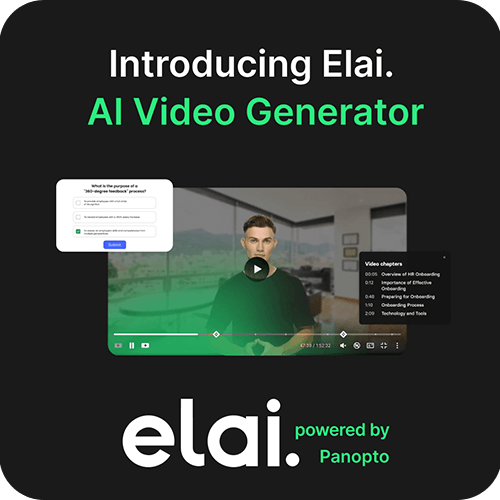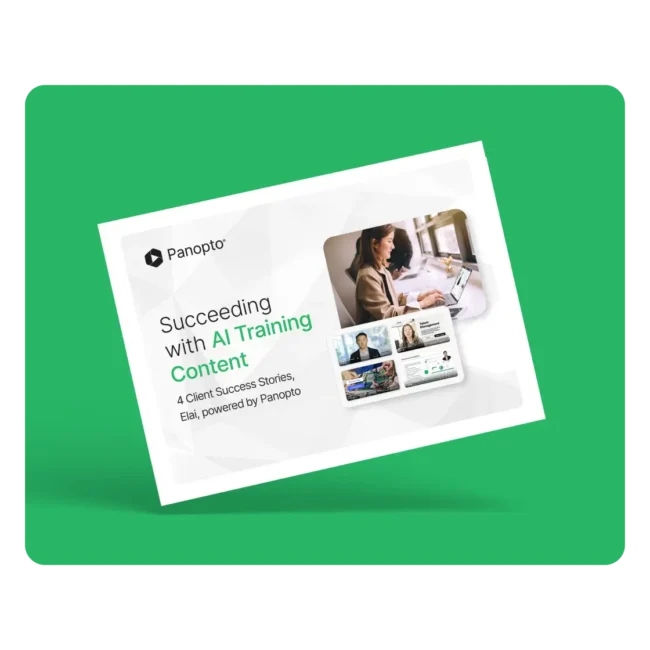- enseignement supérieur
Comprendre les différents types d'IA dans l'apprentissage

L'intelligence artificielle (IA) transforme notre façon de travailler et d' apprendre. Des campus universitaires à la formation de la main-d'œuvre, le pouvoir de l'IA offre des possibilités d'amélioration dans les opérations, les modèles d'apprentissage et plus encore.
Qu'est-ce que l'IA ?
L'IA est un type de technologie qui permet aux ordinateurs et aux machines d'imiter l'apprentissage, la résolution de problèmes, la prise de décision et la créativité de l'être humain. Elle offre plusieurs avantages dans tous les secteurs, tels que l'automatisation des tâches répétitives, l'obtention d'informations plus nombreuses et plus rapides à partir des données, l'amélioration de la prise de décision et l'élimination des erreurs humaines.
Here’s a look at how three types of AI power successful outcomes for the workforce and higher education.
L'IA générative dans l'apprentissage
Comment l'IA générative est-elle utilisée dans l'apprentissage ?
L'IA générative est une technologie d'intelligence artificielle capable de créer de nouveaux contenus tels que de l'audio, du code, des images, du texte et de la vidéo. Il peut rapidement fournir aux apprenants un accès instantané à de grandes quantités d'informations, aider les apprenants ayant des connaissances linguistiques différentes ou des besoins en matière d'accessibilité, et accélérer l'exploration et la créativité.
Trois avantages de l'IA générative pour l'apprentissage.
Personnalisation
Les algorithmes d'IA générative peuvent générer des contenus éducatifs sur mesure, tels que des vidéos ou des articles spécifiques, en fonction des préférences ou des besoins particuliers de l'apprenant.
Automatisation de l'évaluation
Dans l'enseignement supérieur, par exemple, certains enseignants utilisent des outils d'IA générative pour fournir aux étudiants un retour d'information instantané sur leurs travaux.
Apprentissage adaptatif
Les algorithmes informatiques et l'IA peuvent générer des ressources et des activités d'apprentissage personnalisées pour répondre aux besoins uniques des apprenants. Par exemple, si un nouvel employé n'est pas familiarisé avec un logiciel qu'il va utiliser, la formation adaptative peut recommander des modules d'apprentissage qui expliquent comment utiliser le logiciel avant d'aborder des sujets plus approfondis.
Préoccupations concernant l'IA générative dans l'apprentissage.
Malgré ses avantages, l'IA générative n'est pas sans poser de problèmes. Les outils génèrent de nouveaux contenus sur la base des ensembles de données sur lesquels ils ont été formés, et si ces ensembles de données comportent des biais, le nouveau contenu peut également être biaisé. L'IA générative peut également diffuser des informations inexactes, par exemple en citant de fausses études scientifiques comme preuves à l'appui d'un point de vue. C'est probablement la raison pour laquelle les étudiants restent largement sceptiques à l'égard des outils de contenu d'IA générative. Selon une étude récente de Panopto , moins de la moitié des étudiants font confiance à l'IA générative pour générer un contenu précis. Une étude réalisée par Forbes a également montré que 41 % des étudiants déclarent toujours modifier le contenu généré par l'IA, tandis que 3 % déclarent ne jamais le faire.
L'IA prédictive dans l'apprentissage
Comment l'IA prédictive est-elle utilisée dans l'apprentissage ?
L'IA prédictive utilise l'apprentissage automatique pour identifier des modèles dans les événements passés et faire des prédictions sur les événements futurs. L'IA prédictive peut rapidement analyser les données des apprenants dans l'environnement d'apprentissage afin d'obtenir un aperçu de leurs modèles d'apprentissage et de leurs progrès, en prédisant les sujets qu'ils devront apprendre par la suite.
Trois avantages de l'IA prédictive pour l'apprentissage.
Improved outcomes
Predictive analytics can help identify learners who need extra help and provide targeted support, improving their learning outcomes in the long term. For example, all bank employees may need training about a new government regulation affecting financial institutions. Still, one who struggles to answer specific questions might be prompted to take a review course on existing banking regulations to provide them with the necessary background. A college student who keeps rewatching a particular math lecture or asking automated questions about a particular math concept might be prompted to watch or review a lesson about a foundational concept that would help them to understand the new concept better.
Amélioration de la planification
Les instructeurs et les formateurs peuvent utiliser des analyses prédictives pour identifier les domaines d'un programme de formation qui fonctionnent bien et ceux qui doivent être améliorés. Grâce à ces informations, ils peuvent affiner les programmes de formation et les stratégies d'enseignement afin de mieux répondre aux besoins des apprenants.
Amélioration de l'allocation des ressources
L'IA prédictive peut prévoir quels apprenants et quelles cohortes ont besoin de plus de soutien, ce qui aide les organisations ou les établissements d'enseignement supérieur à planifier et à allouer les ressources de la manière la plus bénéfique.
Préoccupations concernant l'IA prédictive dans l'apprentissage.
Comme les analyses prédictives exigent que les organisations collectent et stockent de nombreuses informations sur les apprenants, la confidentialité et la sécurité des données peuvent susciter des inquiétudes. Les établissements d'enseignement supérieur et les organisations qui utilisent l'IA prédictive dans leurs programmes d'apprentissage doivent respecter les lois sur la confidentialité des données et employer des mesures de cybersécurité robustes pour protéger les données qu'ils utilisent. Ils doivent également communiquer avec les apprenants sur les types de données collectées et les mesures prises pour protéger leur vie privée.
L'un des moyens de surmonter les problèmes de protection de la vie privée consiste à s'associer à des fournisseurs qui prennent la question de la protection de la vie privée au sérieux. Par exemple, la politique de confidentialité de l'IA de Panopto, axée sur le client, permet aux organisations de s'aligner sur l'utilisation éthique des données pour la modélisation de l'IA et le développement technologique.
L'IA descriptive dans l'apprentissage
Comment l'IA descriptive est-elle utilisée dans l'apprentissage ?
Les outils d'IA descriptive sont formés pour générer des métadonnées à partir de données non structurées telles que des cours enregistrés ou des documents commerciaux. Ils peuvent découvrir des modèles et des relations entre les données, les classer en divers éléments et résumer les performances passées, les tendances ou d'autres facteurs pertinents.
Trois avantages de l'IA descriptive pour l'apprentissage.
Des informations fondées sur des données. Les outils d'IA descriptive peuvent collecter et analyser des données sur l'interaction de l'apprenant avec le matériel pédagogique, le temps d'exécution, les résultats des tests et les performances. Les instructeurs et les responsables de formation peuvent utiliser ces données pour mesurer le succès d'un programme d'apprentissage et prendre des décisions concernant les programmes futurs.
Prise de notes
Les apprenants peuvent bénéficier d'outils d'IA descriptifs capables de résumer rapidement une vidéo ou un cours et de les aider à prendre des notes sur les points clés. Par exemple, laPanoptosuite de produits Access AI de fournit des transcriptions automatisées, des résumés de points clés et des descriptions de vidéos d'apprentissage d'un simple clic de souris.
Tutorat virtuel
Les tuteurs virtuels alimentés par l'IA descriptive peuvent offrir un retour d'information et un soutien en temps réel dans l'enseignement supérieur, en complément de l'enseignement traditionnel en salle de classe.
Inquiétudes concernant la description de l'IA dans l'apprentissage
Comme pour les autres formes d'IA, la protection de la vie privée et la sécurité restent des préoccupations pour les établissements d'enseignement supérieur et les lieux de travail qui utilisent l'IA descriptive. Il est important d'élaborer des politiques rigoureuses en matière de confidentialité des données et de procéder à des examens pour maintenir la sécurité des données.
Découvrez Panopto AI in Learning
La plateforme d'apprentissage vidéode Panopto, alimentée par l'IA, étend l'apprentissage accessible hors campus pour plus de 1650 institutions éducatives mondiales. Avec des transcriptions et des sous-titres dans plus de 20 langues, une recherche par mot-clé alimentée par l'IA pour aider les apprenants à trouver le contenu rapidement, et des flux de travail automatiques pour la traduction du contenu vidéo, Panopto met à l'échelle l'apprentissage vidéo avec une plateforme facile à utiliser, conçue pour l'éducation.
Derniers blogs
-

- Ventes
How to Make Sales Presentation Videos With AI
A sales presentation can make or break a deal—yet too many sales teams still rely on outdated slides and monotonous pitches. Video content accounts for over 82% of consumer internet traffic. We live in a digital-first world where video is the key to capturing attention and driving engagement. But creating a polished, persuasive sales video…
How to Make Sales Presentation Videos With AI
-

- Apprentissage actif
Why Every Business Needs an Upskilling Strategy (And How to Build One)
A strong upskilling strategy is no longer optional. It’s essential for keeping pace with rapid technological advancements and shifting market demands. As AI and automation reshape industries, companies must ensure their employees continuously develop new skills to stay competitive. But upskilling alone isn’t enough. Reskilling is equally critical for preparing workers to transition into entirely…
Why Every Business Needs an Upskilling Strategy (And How to Build One)
-

- Formation
How to Turn Policy Updates into Just-in-Time Training Videos
In today’s fast-paced workplaces—whether on the manufacturing floor or the trading floor—keeping employees updated on policy changes is critical. But let’s face it: expecting your workforce to sift through long policy documents is unrealistic, especially when time is tight. That’s where the power of just-in-time training videos comes in. This article explores how you can…
How to Turn Policy Updates into Just-in-Time Training Videos



